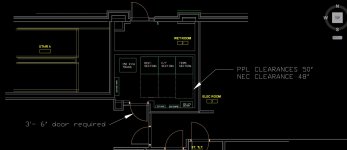LibertyEngineering
Senior Member
- Location
- Allentown, PA
NEC110.26 (C) (2) reads For equipment rated 1200A or more and over 6' wide that contains overcurrent devices, switching devices or control devices, there shall be one entrance and egress from the the required working space.......... I have a 1600A switchboard that is over 6' wide because it includes the utility company cable termination compartment and the instrument transfomer section. The distribution part of the switchboard, the only part that contains overcurrent devices, switching devices or control devices is only 3' wide.
Is it possible to consider only one entrance to/egress from the working space , in this case the main electric room, is required since the only portion that contains the OCPD is 3' wide? I cannot arrange the gear to fall under (a) or (b) at the end of that section
Or am I 'grasping at straws' to look at it this way?
I have reviewed this requirement with countless architects and every project they give me a single door swinging into the room, which is another issue all by itself.
Thanks for looking.
Is it possible to consider only one entrance to/egress from the working space , in this case the main electric room, is required since the only portion that contains the OCPD is 3' wide? I cannot arrange the gear to fall under (a) or (b) at the end of that section
Or am I 'grasping at straws' to look at it this way?
I have reviewed this requirement with countless architects and every project they give me a single door swinging into the room, which is another issue all by itself.
Thanks for looking.


